Research on Risk-Averse Procurement Optimization of Emergency Supplies for Mine Thermodynamic Disasters
Abstract
:1. Introduction
1.1. Background
1.2. Relate Works
1.3. Contribution
- The risk-averse procurement strategy based on the joint reserve framework is proposed in this paper, which considers the optimization of physical supplies and capacity before mine thermodynamic disasters.
- A new P-CVaR distributionally robust model is proposed to characterize decision-makers’ risk preferences based on small-sample and heavy-tailed features of emergency supplies demand distributions for mine thermodynamic disasters.
- An emergency supplies procurement strategy bi-level optimization model is established considering decision-makers’ risk preference to balance the procurement risks and supplier benefits.
2. Problem Description
2.1. Procurement Framework
2.2. Model Assumptions
- The sample of historical emergency material demand can reflect the distribution pattern of the demand variable for mine thermodynamic disasters.
- The random demand variable follows a heavy-tailed distribution with small-samples.
- Each supplier has an ample supply of emergency supplies.
- The emergency management department has the authority to determine the procurement strategy for emergency supplies.
2.3. Symbol Description
3. Model Construction
3.1. Risk Preference Measured Optimization Model
3.1.1. CVaR Distributionally Robust Optimization
3.1.2. P-CVaR Distributionally Robust Optimization Model
3.2. Risk-Averse Procurement Optimization Model
3.3. Model Transformation and Solving
4. Case Analyses
4.1. Hypothesis Testing
4.2. Benefits of the Proposed Models
4.2.1. Benefits of the P-CVaR Models
- Scenario 1:
- Risk-averse bi-level distributionally robust optimization model based on CVaR with second moment and Wasserstein distance.
- Scenario 2:
- Risk-averse bi-level distributionally robust optimization model based on P-CVaR with fractional moments and piecewise number L = 1.
- Scenario 3:
- Risk-averse bi-level distributionally robust optimization model based on P-CVaR with fractional moments and optimal piecewise number L = L* determined by multiple attempts.
4.2.2. Benefits of the Risk-Averse Bi-Level Optimization Model Based on P-CVaR
- Scenario 1:
- Risk-averse bi-level distributionally robust optimization model based on P-CVaR under .
- Scenario 2:
- Risk-averse bi-level distributionally robust optimization model based on P-CVaR under .
- Scenario 3:
- Risk-averse bi-level distributionally robust optimization model based on P-CVaR under .
5. Conclusions
Author Contributions
Funding
Data Availability Statement
Conflicts of Interest
References
- Wang, D.M.; Zhang, W.; Wang, C.G. Uncertain risk characteristics of major thermodynamic disasters in underground coal mines. J. Min. Saf. Eng. 2023, 4, 826–836. [Google Scholar]
- Yi, M. The ‘9·27’ major fire accident at the Chongqing Song Zao Coal Mine resulted in 37 public officials being held accountable. Firef. Sect. 2021, 7, 44–45. [Google Scholar]
- Tian, J.; Zhang, H.Q.; Wang, Y.L. Emergency supplies purchasing model based on capacity option contract with dual purchasing sources. Syst. Eng. Theory Pract. 2013, 33, 2212–2219. [Google Scholar]
- Zhang, J.H.; Sun, X.Q.; Zhu, R.; Li, M.; Miao, W. Solving an emergency rescue materials problem under the joint reserves mode of government and framework agreement suppliers. PLoS ONE 2017, 12, e0186747. [Google Scholar] [CrossRef] [PubMed]
- Zhong, S.; Cheng, R.; Jiang, Y.; Wang, Z.; Larsen, A.; Nielsen, O.A. Risk-averse optimization of disaster relief facility location and vehicle routing under stochastic demand. Transp. Res. Part E Logist. Transp. Rev. 2020, 141, 102015. [Google Scholar] [CrossRef]
- Thevenin, S.; Ben-Ammar, O.; Brahimi, N. Robust optimization approaches for purchase planning with supplier selection under lead time uncertainty. Eur. J. Oper. Res. 2022, 303, 1199–1215. [Google Scholar] [CrossRef]
- Ravindran, A.R.; Bilsel, R.U.; Wadhwa, V.; Yang, T. Risk adjusted multicriteria supplier selection models with applications. Int. J. Prod. Res. 2010, 48, 405–424. [Google Scholar] [CrossRef]
- Lu, J.; Gupte, A.; Huang, Y. A mean-risk mixed integer nonlinear program for transportation network protection. Eur. J. Oper. Res. 2018, 265, 277–289. [Google Scholar] [CrossRef]
- Cai, X.; Zheng, Z.X. Research on the Supply Chain Coordination Based on Mean-CVaR and Production Capital Constraint. Oper. Res. Manag. Sci. 2021, 30, 61–68. [Google Scholar]
- Esmaeili-Najafabadi, E.; Azad, N.; Nezhad, M.S.F. Risk-averse supplier selection and order allocation in the centralized supply chains under disruption risks. Expert Syst. Appl. 2021, 175, 114691. [Google Scholar] [CrossRef]
- Ben-Tal, A.; Teboulle, M. An Old-New Concept of Convex Risk Measures: The Optimized Certainty Equivalent. Math. Financ. 2007, 17, 449–476. [Google Scholar] [CrossRef]
- Liu, B.; Zhang, Q.; Ge, X.; Yuan, Z. CVaR-based approximations of Wasserstein distributionally robust chance constraints with application to process scheduling. Ind. Eng. Chem. Res. 2020, 59, 9562–9574. [Google Scholar] [CrossRef]
- Yao, L.; Wang, X.; Duan, C.; Wu, X.; Zhang, W. Risk-based distributionally robust energy and reserve dispatch with Wasserstein-moment metric. In Proceedings of the 2018 IEEE Power & Energy Society General Meeting (PESGM), Portland, OR, USA, 5–10 August 2018; IEEE: New York, NY, USA, 2018; pp. 1–5. [Google Scholar]
- Cornilly, D.; Rüschendorf, L.; Vanduffel, S. Upper bounds for strictly concave distortion risk measures on moment spaces. Insur. Math. Econ. 2018, 82, 141–151. [Google Scholar] [CrossRef]
- Glasserman, P.; Xu, X. Robust risk measurement and model risk. Quant. Financ. 2014, 14, 29–58. [Google Scholar] [CrossRef]
- Feng, Y.J. Theory and Application of Model Risk Quantification. Ph.D. Thesis, University of Technology, Sydney, Australia, 2019. [Google Scholar]
- Zhang, X.; Low, Y.M.; Koh, C.G. Maximum entropy distribution with fractional moments for reliability analysis. Struct. Saf. 2020, 83, 101904. [Google Scholar] [CrossRef]
- Rodríguez Gálvez, B.; Bassi, G.; Thobaben, R.; Skoglund, M. Tighter expected generalization error bounds via wasserstein distance. Adv. Neural Inf. Process. Syst. 2021, 34, 19109–19121. [Google Scholar]
- Dou, J.X.; Luo, L.; Yang, R.M. An optimal transport approach to deep metric learning (student abstract). Proc. AAAI Conf. Artif. Intell. 2022, 36, 12935–12936. [Google Scholar] [CrossRef]
- Mohajerin Esfahani, P.; Kuhn, D. Data-driven distributionally robust optimization using the Wasserstein metric: Performance guarantees and tractable reformulations. Math. Program. 2018, 171, 115–166. [Google Scholar] [CrossRef]
- Mnatsakanov, R.M. Hausdorff moment problem: Reconstruction of distributions. Stat. Probab. Lett. 2008, 78, 1612–1618. [Google Scholar] [CrossRef]
- Rachev, S.T.; Rüschendorf, L. Mass Transportation Problems: Volume I: Theory; Springer Science & Business Media: Berlin/Heidelberg, Germany, 1998. [Google Scholar]
- Bonafini, M.; Schmitzer, B. Domain decomposition for entropy regularized optimal transport. Numer. Math. 2021, 149, 819–870. [Google Scholar] [CrossRef]
- Ben, T.A.; Margalit, T.; Nemirovski, A. Robust modeling of multi-stage portfolio problems. In High Performance Optimization; Springer: Boston, MA, USA, 2000; pp. 303–328. [Google Scholar]
- Dempe, S.; Kalashnikov, V.; Pérez-Valdés, G.A.; Kalashnykova, N. Bilevel programming problems. In Energy Systems; Springer: Berlin/Heidelberg, Germany, 2015; Volume 10, pp. 973–978. [Google Scholar]
- Zaheri, F.; Zandieh, M.; Taghavifard, M.T. Bi-level programming for supplier selection under quantity discount policy. Sci. Iran. 2017, 24, 2095–2104. [Google Scholar] [CrossRef]
- Nie, R.S. Research on Intelligent Decision Theory and Application for Emergency Resource Allocation of Mine Fire Accidents. Ph.D. Thesis, China University of Mining and Technology, Beijing, China, 2019. [Google Scholar]





| Parametric Variable | |
|---|---|
| The set of candidate suppliers, | |
| Maximum capacity per unit vehicle | |
| Maximum capacity of coal mine warehouse | |
| The budget upper limit for emergency material procurement | |
| Unit inventory cost of physical supplies | |
| If the demand is less than the physical reserve, is 1; otherwise, it is 0 | |
| If the demand is between physical reserves and total reserves, the value is 1, otherwise it is 0 | |
| If the demand is greater than total reserves, it is 1; otherwise, it is 0 | |
| Unit residual value of expired physical supplies | |
| Emergency material demand for mine thermodynamic disasters | |
| The distance from the supplier to the accident coal mine | |
| Unit cost of the supplier transporting supplies to the accident coal mine | |
| The selling unit price of physical supplies provided by the supplier | |
| Reserve unit price of production capacity | |
| The selling unit price of physical supplies produced by production capacity | |
| Shortage unit cost due to insufficient reserves | |
| Unit cost vector of additional physical supplies produced by suppliers | |
| Unit price vector of additional physical supplies produced by suppliers | |
| Unit cost of production capacity into supplies | |
| The unit cost of physical supplies produced by suppliers | |
| Unit cost reserved by supplier’s production capacity | |
| The minimum physical procurement quantity allowed by the supplier | |
| Minimum capacity reserve allowed by the supplier. | |
| Maximum physical supply quantity that the supplier can provide | |
| The maximum capacity reserve that the supplier can provide | |
| Decision variables | |
| Physical reserves quantity purchased from supplier | |
| Capacity reserve quantity purchased from supplier | |
| Accidents | Demand | Accident | Demand | Accidents | Demand |
|---|---|---|---|---|---|
| 1 | 30 tons | 14 | 160 tons | 27 | 20 tons |
| 2 | 220 tons | 15 | 40 tons | 28 | 380 tons |
| 3 | 190 tons | 16 | 23 tons | 29 | 15 tons |
| 4 | 170 tons | 17 | 36 tons | 30 | 27 tons |
| 5 | 420 tons | 18 | 440 tons | 31 | 40 tons |
| 6 | 450 tons | 19 | 320 tons | 32 | 240 tons |
| 7 | 360 tons | 20 | 260 tons | 33 | 270 tons |
| 8 | 45 tons | 21 | 225 tons | 34 | 480 tons |
| 9 | 25 tons | 22 | 520 tons | 35 | 45 tons |
| 10 | 35 tons | 23 | 540 tons | 36 | 105 tons |
| 11 | 180 tons | 24 | 825 tons | 37 | 36 tons |
| 12 | 50 tons | 25 | 32 tons | 38 | 740 tons |
| 13 | 205 tons | 26 | 55 tons | 39 | 500 tons |
| Heavy-Tailed Distribution | Log Likelihood | Fitting Effect |
|---|---|---|
| Lognormal | −250.413 | best |
| Weibull | −250.125 | normal |
| Exponential | −250.134 | better |
| = (0.70, 0.70, 0.70) | = (0.50, 0.40, 0.30) | = (100, 100, 100) | = (100, 150, 300) |
| = (0.20, 0.20, 0.20) | = (0.95, 0.95, 0.95) | = (100, 100, 100) | = (25, 25, 25) |
| = (0.40, 0.45, 0.50) | = (0.40, 0.30, 0.20) | = (500, 500, 500) | = 300 |
| = (0.70, 0.70, 0.70) | = (0.20, 1.50, 0.10) | = (0.15, 0.18, 0.20) | = 1000 |
| = (1.00, 1.00, 1.00) | = (80.0, 80.0, 80.0) |
| Scenarios | Piecewise Number (L) Lnumber Number | Worst-Case CVaR | True CVaR | Relative Error (%) |
|---|---|---|---|---|
| 1 | - | 85.5901 | 58.0546 | 47.4303 |
| 2 | 1 | 79.3031 | 58.0546 | 36.6008 |
| 3 | 6 | 60.7848 | 58.0546 | 4.7028 |
| Scenarios | Scenario 1 | Scenario 2 | Scenario 3 | |
|---|---|---|---|---|
| Risk-Averse Preference | ||||
| 83.3676 | 62.1060 | 72.2192 | ||
| 60.0473 | 74.5196 | 56.7818 | ||
| 64.7256 | 71.8019 | 93.1394 | ||
| total y | 208.4275 | 208.1405 | 208.4275 | |
| 135.9968 | 145.2650 | 224.9239 | ||
| 100.4338 | 131.2661 | 125.3373 | ||
| 166.3836 | 144.5964 | 150.6712 | ||
| total z | 402.8142 | 402.8142 | 421.1275 | |
| total | 610.9547 | 629.5550 | 723.0728 | |
| 34.0680% | 33.1071% | 30.7217% | ||
| 65.9320% | 66.8929% | 69.2783% | ||
Disclaimer/Publisher’s Note: The statements, opinions and data contained in all publications are solely those of the individual author(s) and contributor(s) and not of MDPI and/or the editor(s). MDPI and/or the editor(s) disclaim responsibility for any injury to people or property resulting from any ideas, methods, instructions or products referred to in the content. |
© 2024 by the authors. Licensee MDPI, Basel, Switzerland. This article is an open access article distributed under the terms and conditions of the Creative Commons Attribution (CC BY) license (https://creativecommons.org/licenses/by/4.0/).
Share and Cite
Li, W.; Gao, L. Research on Risk-Averse Procurement Optimization of Emergency Supplies for Mine Thermodynamic Disasters. Mathematics 2024, 12, 2222. https://doi.org/10.3390/math12142222
Li W, Gao L. Research on Risk-Averse Procurement Optimization of Emergency Supplies for Mine Thermodynamic Disasters. Mathematics. 2024; 12(14):2222. https://doi.org/10.3390/math12142222
Chicago/Turabian StyleLi, Weimei, and Leifu Gao. 2024. "Research on Risk-Averse Procurement Optimization of Emergency Supplies for Mine Thermodynamic Disasters" Mathematics 12, no. 14: 2222. https://doi.org/10.3390/math12142222




